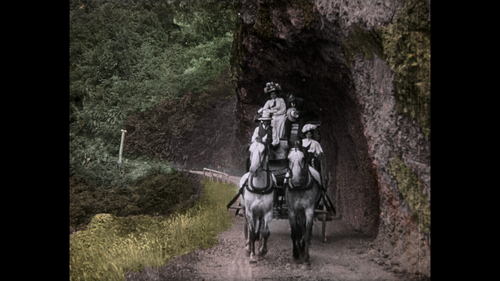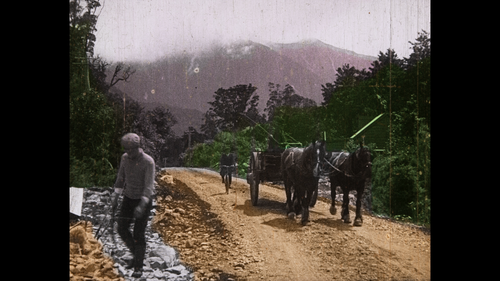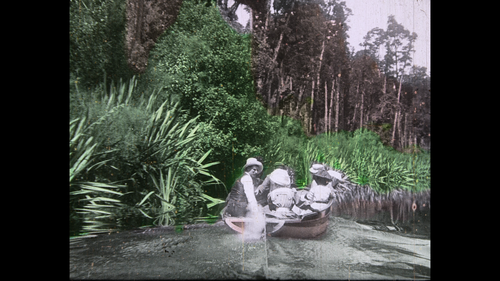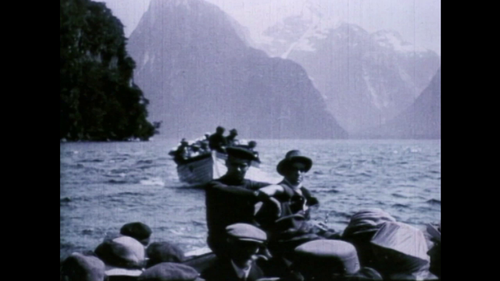
Above image: Screengrab from Coasts of New Zealand.
In 1909, Mr. W. Franklyn Barrett of the renowned French film-making firm Pathé Frères was entrusted to travel through New Zealand and capture scenic sights that the world would otherwise not know existed. Barrett did exactly that, and the fruits of his labour were later featured in two short films from Pathé Frères – Across the Mountain Passes of New Zealand, and Coasts of New Zealand.
The opening shots in Across the Mountain Passes of New Zealand follow a horse-drawn passenger coach as it winds its way through the beautiful and perilous Buller Gorge and bushy South Island surrounds. Notably, the footage has some colour – rare for the time. This was achieved in post-production by cutting stencils for each colour and hand-painting each frame of film. The technique adds an impressive depth of field effect to the otherwise black and white footage. It also emphasises the abundance of green within the South Island valleys.

The coach on its journey through the Buller Gorge
Next, we watch as the coach driver grabs mail that has been conveniently hung by the roadside for collection. Note how well-maintained the roading is for such an isolated region. We see a man comfortably riding along on bicycle, trailing a horse-drawn cart.

A well-maintained road in the midst of a pristine mountain landscape
Barrett’s film then turns its attention to New Zealand’s waterways. After an impressive establishing shot of men and women gathered by a wharf, we watch a large carriage with evidently very sturdy wheels crossing a river ford. We then take a trip down a much calmer waterway with unmistakably New Zealand vegetation at either side. A small, motorised passenger boat in frame is tugging the vessel upon which Barrett’s camera is filming. Barrett would surely have sighed a breath of relief when his camera and precious footage made it to the end of his venture intact.

What looks to be a pleasant journey down the river
Barrett’s second film, Coasts of New Zealand, spotlights tourism in the lower South Island. The opening shots showcase Milford Sound, and we see impressive numbers of visitors viewing the classic panorama from aboard boats. British writer Rudyard Kipling had visited Milford Sound in the 1890’s and declared it ‘the eighth wonder of the world’, so the popularity a decade or so later is of no great surprise.

Visitors being ferried across Milford Sound, Mitre Peak claiming the backdrop
The film then captures the journey of tourists who have boldly chosen to traverse a land route in order to reach ‘the most picturesque spots’. The exact route is unclear; however, we later see the tourists reaching and climbing Franz Josef Glacier. What is striking – and somewhat sobering – is seeing footage of the glacier sprawling far down the valley. In years since, a changing climate has seen it retract steadily into the chillier alpine heights. We are fortunate to have Barrett’s visual record of the glacier in its former days.

Intrepid visitors walk across glacial ice
In February of 1910, The Dominion published an article about Barrett’s successful endeavour. In the article, he is quoted saying, “I believe that I have secured some of the finest scenic views ever kinematographed in the world, and its exhibition in all parts of the world should do New Zealand incalculable good, as it brings the scenic glories of New Zealand directly under everyone’s notice, no matter in what city or country they live.”
No doubt, Barrett was right, and his footage drew many visitors to the shores of this country – renowned still for its scenic wonder.
Some of Barrett’s footage was selected and features in our 2019 film Ngā Wai e Rua: Stories of Us – which showcases some of New Zealand’s audiovisual taonga cared for by Ngā Taonga.
There is plenty more historic footage of New Zealand’s scenic locations available to view in our online catalogue.
Further viewing: